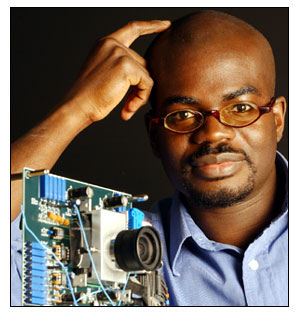STANFORD, Calif., March 29, 2006 -- Microchips that function like the brain or that "see" like eyes were once thought to be in the same futuristic category as flying cars and robot housekeepers. But at least one researcher thinks such "neuromorphic" processors are becoming more of a likelihood. 
Kwabena Boahen leads a research group that is trying to mimic the functions of the brain’s complex neural system using silicon chips. (Photo courtesy of Kwabena Boahen)
"We are taking knowledge from neuroscience and using it to build better computers," said Kwabena Boahen, an associate professor in Stanford University's department of bioengineering. Boahen hopes his research will lead to small computers that could replace damaged neural tissue or silicon retinas that restore vision. He believes understanding how the brain functions could help make computation more efficient.
Boahen's interest in intelligent computing goes back to his childhood in Ghana. When he received his first computer as a teenager, he said, the machine fascinated him. Being an inquisitive child and the son of a professor, Boahen went to the library to learn everything he could about his new machine.
What he learned, he said, appalled him.
"When I tried to figure out how computers worked, I was disgusted," Boahen said. "I thought it was totally brute force. I felt there had to be a more elegant way to do this."
When Boahen came to the United States for his undergraduate education at Johns Hopkins University, he said, he discovered a better way: neural network computing, or adaptive computational models that change the way they work as they are fed new information.
"Soon after I got to the United States, I learned about neural networks and I thought [they were] really elegant," Boahen said. "You could present a bunch of examples to the network and it would learn."
Boahen began studying very large scale integration, or VLSI, circuits. These experiences led him to design an associative memory chip that, using pattern recognition, would "learn" to associate pictures with the words used to describe them.
"It didn't work at all," Boahen said, laughing. "It was a disaster."
Boahen was more successful as a graduate student at the California Institute of Technology under the tutelage of Carver Mead, a prominent computer scientist. There he learned to take the circuits neurons form and implement them on a microchip. After earning his doctorate from Caltech in 1997, Boahen became a professor in the bioengineering department at the University of Pennsylvania. During his eight years at Penn, he developed a silicon retina that was able to process images in the same manner as a living retina. He confirmed the results by comparing the electrical signals from his silicon retina to the electrical signals produced by a salamander eye while the two retinas were looking at the same image.
In January, Boahen came to Stanford, where he will turn his attention to studying how learning and memory work in the human brain.
"What we're trying to do now is to build chips with something like 100,000 neurons on [them] and then build a multiple-chip network that gets up to about 1 million neurons," Boahen said. "With a network of that size, you can model what the different cortical areas are doing and how they are talking to each other."
These cortical areas in the brain each handle different tasks. Some are responsible for our use of language, while others are responsible for processing the images we see or the sounds we hear. Boahen would like to model their functions on an artificial network so he can learn more about how the brain works.
His goal is to eventually create a silicon computer that works as efficiently as the human brain. According to Boahen, the brain is capable of performing 10 quadrillion (that's 10^16) "calculations," or synaptic events, per second using only 10 watts of power. At this rate, he said, a computer as powerful as the human brain would require 1 gigawatt of power.
"If we are able to figure out how these neurons organize themselves, it's going to provide a solution we need down the road to build more powerful computers," said Boahen.
Apart from advancing computing, Boahen's research might one day help those afflicted with neurology-related conditions.
"If you, unfortunately, lost your hearing or had a stroke and had some neural tissue that needed to be replaced, and if we could build something that uses as little power as the brain does and uses as little space as that neural tissue does, then we could replace it," he said.
Although it would be easy to frame Boahen's research in recreating the brain as the stuff of science fiction, he said he prefers to focus on its practical applications.
"I'm not driven by the sci-fi thing," he said. "It's probably because I grew up in Ghana and, by the time I was exposed to it, I was too critical. I'm sort of a nuts-and-bolts guy."
For more information, visit: www.stanford.edu